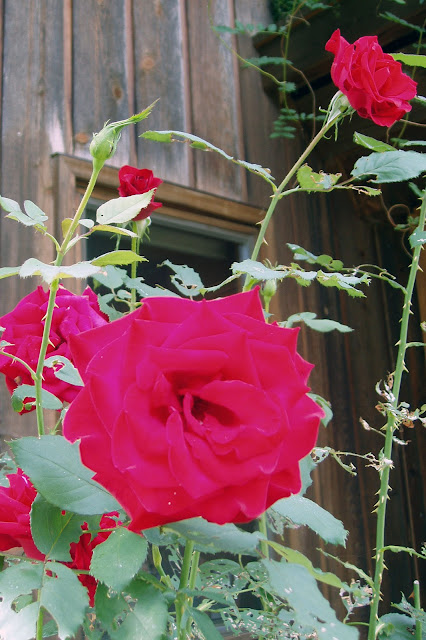jack o'lanterns glow --
costumed kids walk door to door
for trick-or-treat
I like this little girl's lady bug costume because it looks homemade and I like the real, not plastic, pumpkins for sale, and I like the Jack O'Lanterns made from real pumpkins. When I grew up, in the 1950s in St. Louis, Missouri, Halloween was very much a homemade affair, from Jack O'Lanterns to costumes to treats.
The day began with our father carving the pumpkin. He used a long, sharp knife to cut off the top of the pumpkin, which looked like a little orange cap with a green tassel. Then he put us to work digging out the seeds and pulp. Next, he carved a grimacing face with pointed teeth. Then he melted the bottom end of a candle and stuck it inside the pumpkin. That evening, he set the Jack O'Lantern on the front porch, lit the candle and placed the cap on top. The flickering candle made the hideous face glow in a delightfully scary way. This carved pumpkin was not thrown away after Halloween. Instead, my mother toasted the seeds for snacks and made a pie from the orange flesh.
Meanwhile, my older sister and I put on our costumes. I liked dressing up as a witch with a black hat made from construction paper. We took our brown paper bags and walked from lighted door to door, passing groups of kids disguised as ghosts in white sheets, goblins with brown paper bag masks, skeletons with white bones painted on a black sweater and pants, princesses in flowery nightgowns with tinfoil crowns, gypsies with red bandanas on their heads, and hobos in ragged blue jeans. It was exciting, being out at night by ourselves. In those days this was quite safe as long as you stayed in your own neighborhood. At each house we rang the doorbell and an adult would appear. "Trick or treat!" we cried. The neighbor: "Well, what's your trick?" Then we had to recite a riddle or make a pun or tell some joke before we could get our treats.
One year I dressed as a teapot, stuffing a white sweater with newspaper and wearing a white cap knit by Grandma. When asked for my "trick," I placed my hands on my hips, arms crooked, and sang: "I'm a little teapot, short and stout. Here is my handle . . . " I glanced down at my left arm. "Here is my spout . . . " I looked with surprise at my right arm, crooked like the left arm, and said, "Oh, darn, I'm a sugar bowl!"
The treats were often homemade (and hand-wrapped) cookies, popcorn balls or candied apples. Or we might be given a handful of peanuts, jelly beans, candied corn or bubble gum. Rarely, we might receive a "mini-bar" Baby Ruth, Butterfinger, Hershey, Heath or Milky Way. When we got home, we counted our treats and ate the ones that wouldn't keep, then hoarded the rest, nibbling them one by one all the way to Thanksgiving.
















































